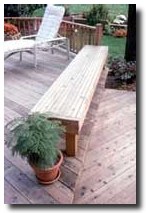❖ Designing a Deck: Part 3Page: 1 | 2 | 3 | 4 | 5 | 6 | 7 |
» Elevated Decks Because elevated decks sit well above the ground, many local building codes require railings around them. Since railings will be the most visible part of any elevated deck, consider them carefully. If you live in snow country, avoid railings with balusters fastened to the joists that run around the deck's rim. This makes it very difficult to sweep snow off the deck. Choose a railing with balusters that end at a bottom rail, so there's an open area for snow removal. Built-in benches, as shown here, complement the overall design and help to separate different deck levels. Because elevated decks sit well above the ground, many local building codes require railings around them. Since railings will be the most visible part of any elevated deck, consider them carefully. If you live in snow country, avoid railings with balusters fastened to the joists that run around the deck's rim. This makes it very difficult to sweep snow off the deck. Choose a railing with balusters that end at a bottom rail, so there's an open area for snow removal. Built-in benches, as shown here, complement the overall design and help to separate different deck levels.
The post-and-beam framework that supports the joists for an elevated deck is not just a structural consideration. It will be visible, so it needs to be as handsome as possible. Closely spaced 4 x 4 posts look good in some situations; in others, you may want to go with larger beams supported by 6 x 6 posts spaced farther apart. Placing the posts at the outer edge of the deck can look clunky. Instead, you might want to position a post-and-beam supporting structure several feet inside the deck's perimeter and cantilever the joists. An elevated deck may need a stairway. If yours does, you'll find it can be a challenge to work one into your design. A straight stairway is easiest to build, but not always suitable. A landed stairway takes up less room. Building inspectors tend to be sensitive about stairways, so make sure to comply with local code requirements that specify minimum stairway width, railing measurements and tread sizes ... 
|
🌵 Search azWoodman
 We are a participant in the Amazon.com Services LLC Associates Program, an affiliate advertising program designed to provide a means for sites to earn advertising fees by advertising and linking to Amazon.com.
We are a participant in the Amazon.com Services LLC Associates Program, an affiliate advertising program designed to provide a means for sites to earn advertising fees by advertising and linking to Amazon.com.
